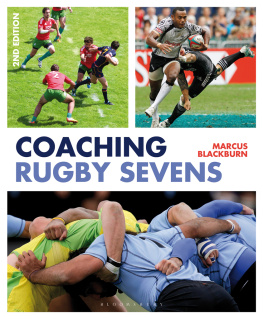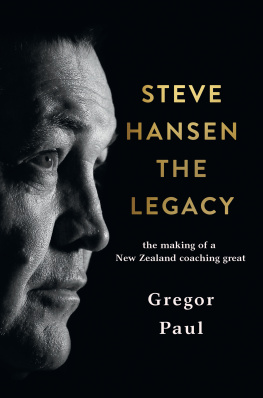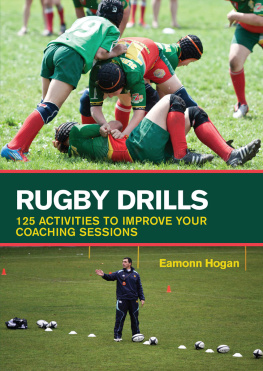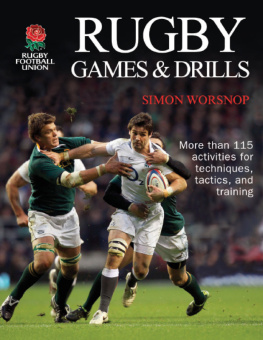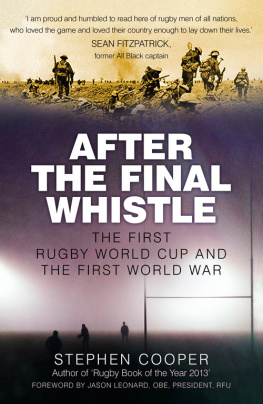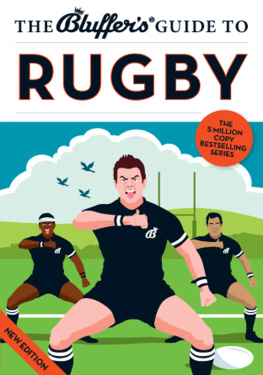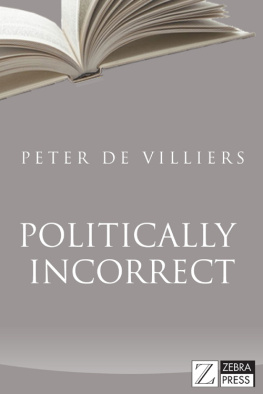Marcus Blackburn - Coaching Rugby Sevens
Here you can read online Marcus Blackburn - Coaching Rugby Sevens full text of the book (entire story) in english for free. Download pdf and epub, get meaning, cover and reviews about this ebook. year: 2014, publisher: Bloomsbury Publishing, genre: Children. Description of the work, (preface) as well as reviews are available. Best literature library LitArk.com created for fans of good reading and offers a wide selection of genres:
Romance novel
Science fiction
Adventure
Detective
Science
History
Home and family
Prose
Art
Politics
Computer
Non-fiction
Religion
Business
Children
Humor
Choose a favorite category and find really read worthwhile books. Enjoy immersion in the world of imagination, feel the emotions of the characters or learn something new for yourself, make an fascinating discovery.
- Book:Coaching Rugby Sevens
- Author:
- Publisher:Bloomsbury Publishing
- Genre:
- Year:2014
- Rating:4 / 5
- Favourites:Add to favourites
- Your mark:
- 80
- 1
- 2
- 3
- 4
- 5
Coaching Rugby Sevens: summary, description and annotation
We offer to read an annotation, description, summary or preface (depends on what the author of the book "Coaching Rugby Sevens" wrote himself). If you haven't found the necessary information about the book — write in the comments, we will try to find it.
Coaching Rugby Sevens — read online for free the complete book (whole text) full work
Below is the text of the book, divided by pages. System saving the place of the last page read, allows you to conveniently read the book "Coaching Rugby Sevens" online for free, without having to search again every time where you left off. Put a bookmark, and you can go to the page where you finished reading at any time.
Font size:
Interval:
Bookmark:

For my boys, Jack and Rory
Note
While every effort has been made to ensure that the content of this book is as technically accurate and as sound as possible, neither the author nor the publishers can accept responsibility for any injury or loss sustained as a result of the use of this material.
Published by Bloomsbury Publishing Plc
50 Bedford Square
London WC1B 3DP
www.bloomsbury.com
First edition 2006
Second edition 2013
This electronic edition published in 2014 by Bloomsbury Publishing Plc
Copyright 2006, 2013 Marcus Blackburn
ISBN (print): 978-1-4081-9213-9
ISBN (ePdf): 978-1-4081-9214-6
ISBN (ePub): 978-1-4081-0836-9
All rights reserved
You may not copy, distribute, transmit, reproduce or otherwise make available this publication (or any part of it) in any form, or by any means (including without limitation electronic, digital, optical, mechanical, photocopying, printing, recording or otherwise), without the prior written permission of the publisher. Any person who does any unauthorised act in relation to this publication may be liable to criminal prosecution and civil claims for damages
Marcus Blackburn has asserted his rights under the Copyright, Design and Patents Act, 1988, to be identified as the author of this work.
Acknowledgements
Cover photographs Pavel L Photo and Video/Shutterstock.com (top left); Kin Cheung/AP/Press Association Images (top right); Julie Jacobson/AP/Press Association Images (bottom)
Inside photographs, see
Illustrations composed from cut-outs by David Gardner
To find out more about our authors and their books please visit www.bloomsbury.com where you will find extracts, author interviews and details of forthcoming events, and to be the first to hear about latest releases and special offers, sign up for our newsletters here.
CONTENTS

FOREWORD
The game of rugby is at an exciting stage. As I write this there are 100 countries included in the official International Rugby Board world rankings for the 15-a-side version of the game. The most significant development in recent years, however, is the growth of the seven-aside game, for both male and female participants. This has been boosted by an incredibly popular and high quality world series of competitions and the inclusion of sevens as an Olympic sport.
Throughout the rugby world there are literally hundreds of coaching manuals and books that provide advice for players and coaches. Nearly all of them focus on the 15-a-side game. What is becoming obvious as time passes is that the skill set and tactics for the 15-a-side game do not apply to the seven-a-side version. There is a relative ignorance of the tactics and specialist sevens practice schedules in the majority of clubs and unions. Until now a potential sevens player or coach has little choice of useful reference material to turn to for assistance.
Marcus has enjoyed a close relationship with sevens both as a player and a coach. It is clearly his favourite version of the game. Although, like many of us, much of his time is taken up coaching the fifteen-a-side version of rugby, he has continued to follow and coach sevens when the opportunity arises. This has enabled him to refine and clarify his thinking and to be acutely aware of the difference between the 15-a-side and the sevens versions of the game.
This second edition of his book has been extensively revised in both organisation and contents, and provides an easy-to-understand guide for the preparation of players. Marcuss thoughts are clearly presented and supported with easy-to-follow diagrams. Tactical options are clearly distinguished from practice activities, all of which are designed to develop the skill and decision-making applicable to the game. The book offers an enhanced understanding of the sevens game and provides a squad with both theory and practice to make it competitive.
I believe that the book is a groundbreaking and effective addition to the family of rugby coaching manuals, and contains useful advice that is relevant for both players and coaches at all levels.
Brian OShea
July 2013

INTRODUCTION
Congratulations! You have just taken a huge step towards producing better rugby players and not just for the sevens field. As you will have discovered, there are few coaching resources for the game of rugby sevens. This book does not just aim to fill the void, but to extend and accelerate education on the game, for coaches and players. The IRBs Laws of the Game should be referred to alongside the book, not only to promote up-to-date knowledge of the laws, but also to importantly connect readers with the world governing body for the game of Rugby Union.
On a tactical level, there is no bigger consideration than the number of players on the field. If you watch rugby sevens for long enough, a game of fifteens looks like it is being played on a postage stamp! Picture seven players spread out across the full width of a rugby field, and you will also picture the vast amount space available. Space is the number one principle of the game, and should be the biggest consideration in coaching rugby sevens.
From a technical perspective, it could be argued that the width of the pass is the key distinctive of sevens over fifteens, considering that most passes in sevens are longer than most passes in fifteens, and the inability to make long passes can certainly inhibit the use of space. However, an interesting statistic from a recent game between two top nations questions the value of passing in the game. Fiji beat Samoa by 19 points to 7, in a game when Samoa completed 69 passes and Fiji completed only 8! We can learn a lot from this, and unsurprisingly from Fiji in general.
Firstly, on possession. It has been asserted a countless number of times that possession is the key to the game. Sure, you have to have the ball to score, but Fiji teaches us that purposeful and productive possession is actually the key to success. Their alignment facilitated this, and gave them a framework to exploit their talents. Specifically, they demonstrated how a deliberate and spread alignment can expand and stretch the defence to create space to run.

There is no doubt that the Fijian players had superlative running skills to break the Samoan defence, and outstanding defensive qualities to contain the Samoan attack. In this regard, sevens should be recognised as a game that requires, and develops, players with a complete skill set players who are less specialist in terms of their position, who can attack and defend, can secure ball in contact, make decisions under pressure and communicate under fatigue. And then be fit enough to show repeat-efforts in all of the above. The game should not be viewed as an abbreviated form of rugby; rather, that it is rugby magnified. It is a closer inspection of the overall skills of rugby. Due to the increased exposure to a one-on-one situation, sevens enforces player accountability and promotes technical accuracy and, through this, provides a brilliant education for rugby players.
Next pageFont size:
Interval:
Bookmark:
Similar books «Coaching Rugby Sevens»
Look at similar books to Coaching Rugby Sevens. We have selected literature similar in name and meaning in the hope of providing readers with more options to find new, interesting, not yet read works.
Discussion, reviews of the book Coaching Rugby Sevens and just readers' own opinions. Leave your comments, write what you think about the work, its meaning or the main characters. Specify what exactly you liked and what you didn't like, and why you think so.

